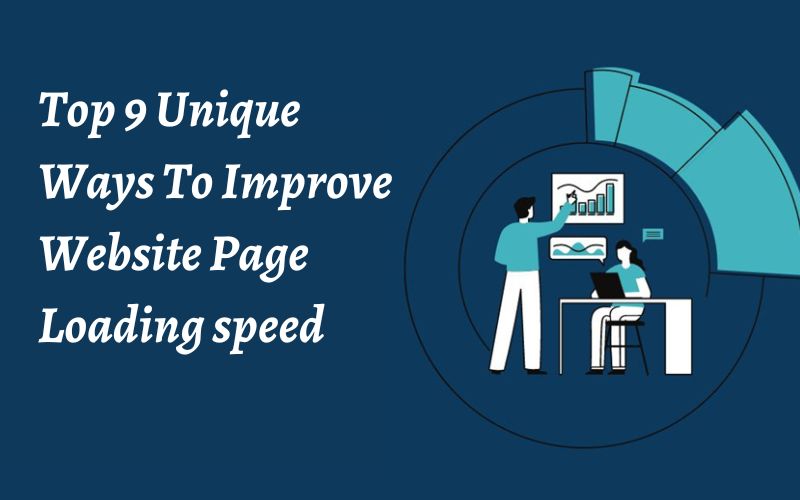Each of the extra seconds of loading time impacts your conversion rate by 4.42% within the first five seconds customers spend on your site. According to another study, every one-second delay in your website’s loading speed results in 11% fewer page visits and a 16% decrease in customer happiness.
Quick Takeaways
- Almost all of the websites now load in just under five seconds.
- The first step in increasing website speed is to assess your existing performance.
- Visual material is essential for websites, but it can slow down download speeds if images are not properly optimized.
- Returning users benefit from additional seconds saved by browser caching.
- Using a minimalist approach to website design can improve the overall speed of your website.
Website speed is increasing, and user expectations are rising in tandem. According to research, 78% of all pages on websites currently load in 5 seconds or less. The speed of website development companies is very high. One of these companies is a web development company in India. We already know that the first five seconds are critical, and if your website doesn’t load in that 0–4 second period, you’re likely falling behind your competition.
9 Simple Ways to Speed Up Website Loading
- Check the loading speed of your web page
- GTmetrix
- Google’s Page Speed Insights
- Dareboost
- Optimize images
- Before publishing, shape and resize images using image editing software.
- After that, compress your photographs. Tiny PNG, a free image compression tool, will reduce file size without compromising image quality.
- Try it with all of your website’s photographs. Before you begin, test your website’s speed. Then resize, compress, and re-upload the image. Assess your site a second time to see how fast it opens.
- Enable compression
- Minify your code
- Reduce redirects
- Decide on a service provider that focuses on performance The speed of your website can be significantly influenced by your web host. Your web server acts as a go-between for all of the data and pages on your website and the visitors to it. When you go for subpar (or worse) hosting in an effort to save money, you run the danger of long-term performance concerns that might have detrimental effects. Trust me when I say it’s worthwhile to spend money on dependable, high-quality hosting that enhances the efficiency of your website.
- Make use of a content delivery network.
- Accept minimalism
- Utilize browser and website caching
For you to improve website speed, you must first understand where it is now. You can assess your current website speed using the following free tools:
These applications not only tell you how long it takes for your website to load, but they also make precise recommendations to improve website speed, SEO, and security. Even if you follow the methods in this article and enhance your site’s speed, I recommend using these tools on a regular basis to track your progress and promptly handle any new issues that arise.
Images of good quality and resolution are essential for boosting your written material. Every blog article, landing page, and static page on your site benefits from visual content to help express the story you’re attempting to tell. It also improves the user experience of your content. However, if you’re not careful, these same images will weigh down your website like a ton of bricks, considerably slowing down download time.
Here’s the solution: –The compression of files may already be enabled on your website. It’s important to check to make sure it’s enabled if you’re doubtful. It’s enabled. Your file size can be reduced by 50% or more just by activating this setting. To check if your site is enabled, use this free GZIP compression tool In order to set it up, proceed by adapting the following instructions to your web server setup It’s typically as simple as adding some code to your website’s file management.
Going shorter and loading quicker seems to be the trend as we discuss how to speed up websites. We now get to the topic of minifying. You’ll probably find a recommendation to "minify JavaScript, CSS and HTML" when you analyse the page performance of your website Another technique for reducing file size is minifying, which eliminates superfluous components without affecting how your website looks or functions. In other words, by removing white space, line breaks, extraneous letters, and programmer comments from your files, you’re cleaning up the code of your website development company in Jaipur. Originally, these extra letters and spaces were included to make your code easier to understand for programmers. Your website won’t change if you remove them, but the download size will decrease.
Your website’s loading time may be greatly delayed by frequent redirections. Your website’s users must wait longer for the HTTP request-response cycle to finish each time it reroutes them to a different page. While certain redirections are unavoidable, you may speed up your website by removing unnecessary ones. You may utilize several useful tools to assist you in doing so, such as this redirect mapper or the website crawler from Screaming Frog.
You may remove the redirects you don’t need to increase website speed once you’ve found the duplicates and the ones that aren’t really doing anything.
By keeping copies of your website at several data centers around the world, content delivery networks (CDNs) are networks of servers that provide quicker and more dependable access to your website. CDNs function alongside your web hosting platform, not instead of it. By shortening the distance between browsers and the host servers of your website, they increase website performance. Here is further information on how to identify the characteristics of a good CDN provider from the many available.
The last stage is to simplify your website. Think carefully about how your website’s visual content, plugins, widgets, and website redirection all contribute to its value. Remove any that don’t seem to have a purpose. Think about the phrase "less is more" when it comes to design. Avoid overcrowding your website with resources that must be loaded if they aren’t genuinely guiding visitors towards a certain objective.
When a user returns to your website, browsers employ caching to avoid having to refresh the full page. Stylesheets, pictures, JavaScript files, and other objects are all cached by them. We are aware of the necessity of enhancing website performance for first-time visitors, but allowing caching can further reduce the already-short loading time for repeat visitors. Why not benefit from this?





